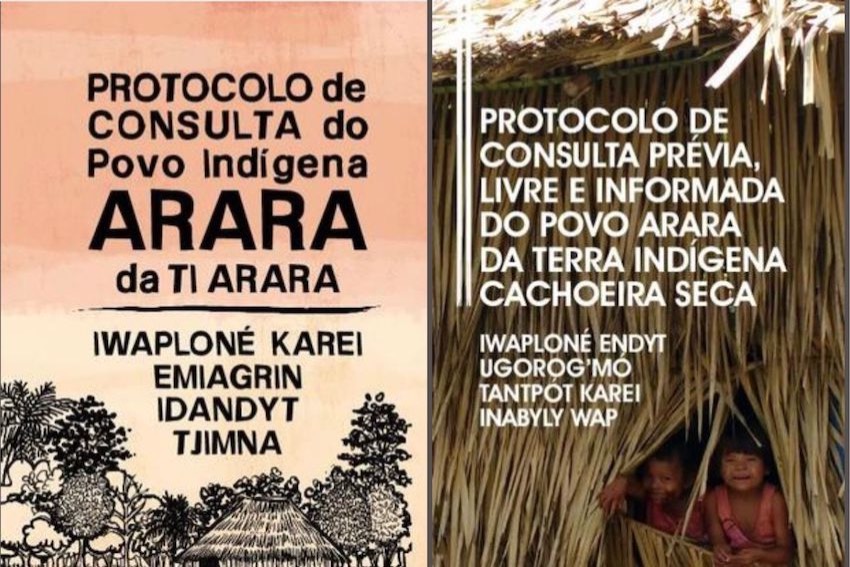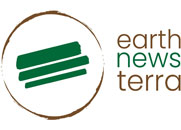Arara indigenous people publish rules on approaching their villages

Covers of the Araras consultation protocols. Photo: reproduction
Have you ever thought about the rules someone must follow to approach you, to propose something to you? Perhaps these rules are implicit in your life. Maybe you had to think about them and even fight for them. Maybe you’ve never been threatened. Maybe you have. These issues become more critical when you belong to a people whose land, vital to them, has been coveted by stronger groups belonging to another culture.
This is the case of the Arara people of the Cachoeira Seca and Arara indigenous lands, in Pará. The territory in which they lived was systematically invaded by loggers and other explorers after the construction of the Trans-Amazonian Highway in the 1970s and 1980s. Since then, they have had to think about how contact with outsiders should be made. They learned, for example, that when government or business representatives approach them to propose something, they need to inform themselves, prepare in advance, organize themselves for these conversations, otherwise, they accept offers or impositions that will later prove destructive for them.
It was based on these traumas experienced over decades that the Araras decided to create two “Protocols for Prior, Free and Informed Consultation of the Arara People”, one for each indigenous land. The texts begin with what they learned from their contacts with outsiders. Reading these reports, one understands why they decided to establish these contact rules.
Reading this saga is exciting and very educational. The documents contain beautiful pictures of the villages, which transport us to the life of the indigenous people in the forest.
The Arara of the Cachoeira Seca Indigenous Land introduce themselves like this: “We are the Ugorog’mó people who live in the Indigenous Land Cachoeira Seca, on the banks of the Iriri River, in the center-west of the state of Pará. We are also known to the karei (non-indigenous) and other indigenous relatives as the Arara people. We are a happy, strong and resilient people. Our people have lived for hundreds of years in the forests on the banks of the Iriri River, hunting and gathering. The forest is still our home. We know the forest deeply, more than anyone. A few generations ago, our people and the Arara who live in Arara Indigenous Land were the same people, but one day we parted ways”.
In another passage, they observe: “In addition to the government, entrepreneurial companies also make decisions about our lives without even talking to us first. The government allows this to happen. This is wrong”.
Those from the Arara Indigenous Land tell the following: “We live in the Arara Indigenous Land on the left bank of the Iriri River, which also borders the Transamazon Highway to the north. Before the contact with the karei (white), which took place from 1978 to 1984, we lived in the forest in small groups, walking a lot through a large territory that went from Santarém to Altamira. Our small groups met from time to time to exchange information, celebrate with the traditional drink made from the inajá, aremgu, and hold weddings. When construction began on the Trans-Amazonian, right before 1970, many karei arrived. Our territory began to be invaded and the forest began to be cut down. We got scared and ran away. We left houses, gardens, fruit-gathering and fishing grounds, even our dead had to be left behind. We had a homeland in what is now the city of Medicilândia, KM 90 of the Trans-Amazonian Highway. After the first invasions, we started to walk a lot more, changing places every day. Therefore, we also ended up abandoning our agriculture”.
The document goes on further: “Today we live in a great struggle, resisting invaders who arrive in search of wood, squatters who try to subdivide our land, prospectors in search of ore, fishermen and hunters stealing our food. Today we are worried, fighting to protect our territory and seeing the forest, which is our life, disappear around our land, reducing the space of forest for our game to reproduce”.
There’s so much more. The protocol for Cachoeira Seca is 80 pages long and that for Arara, 52. Both are (in Portuguese) on the Instituto Socioambiental website, in PDF documents, at the following links:
Protocol of Consultation of the Arara Indigenous People of the Arara Indigenous Land.

Leave a comment